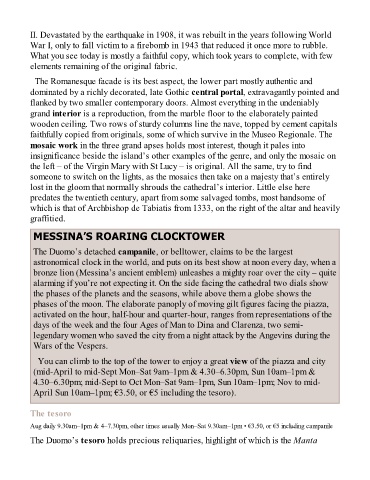Page 261 - The Rough Guide of Sicily
P. 261
II. Devastated by the earthquake in 1908, it was rebuilt in the years following World
War I, only to fall victim to a firebomb in 1943 that reduced it once more to rubble.
What you see today is mostly a faithful copy, which took years to complete, with few
elements remaining of the original fabric.
The Romanesque facade is its best aspect, the lower part mostly authentic and
dominated by a richly decorated, late Gothic central portal, extravagantly pointed and
flanked by two smaller contemporary doors. Almost everything in the undeniably
grand interior is a reproduction, from the marble floor to the elaborately painted
wooden ceiling. Two rows of sturdy columns line the nave, topped by cement capitals
faithfully copied from originals, some of which survive in the Museo Regionale. The
mosaic work in the three grand apses holds most interest, though it pales into
insignificance beside the island’s other examples of the genre, and only the mosaic on
the left – of the Virgin Mary with St Lucy – is original. All the same, try to find
someone to switch on the lights, as the mosaics then take on a majesty that’s entirely
lost in the gloom that normally shrouds the cathedral’s interior. Little else here
predates the twentieth century, apart from some salvaged tombs, most handsome of
which is that of Archbishop de Tabiatis from 1333, on the right of the altar and heavily
graffitied.
MESSINA’S ROARING CLOCKTOWER
The Duomo’s detached campanile, or belltower, claims to be the largest
astronomical clock in the world, and puts on its best show at noon every day, when a
bronze lion (Messina’s ancient emblem) unleashes a mighty roar over the city – quite
alarming if you’re not expecting it. On the side facing the cathedral two dials show
the phases of the planets and the seasons, while above them a globe shows the
phases of the moon. The elaborate panoply of moving gilt figures facing the piazza,
activated on the hour, half-hour and quarter-hour, ranges from representations of the
days of the week and the four Ages of Man to Dina and Clarenza, two semi-
legendary women who saved the city from a night attack by the Angevins during the
Wars of the Vespers.
You can climb to the top of the tower to enjoy a great view of the piazza and city
(mid-April to mid-Sept Mon–Sat 9am–1pm & 4.30–6.30pm, Sun 10am–1pm &
4.30–6.30pm; mid-Sept to Oct Mon–Sat 9am–1pm, Sun 10am–1pm; Nov to mid-
April Sun 10am–1pm; €3.50, or €5 including the tesoro).
The tesoro
Aug daily 9.30am–1pm & 4–7.30pm, other times usually Mon–Sat 9.30am–1pm • €3.50, or €5 including campanile
The Duomo’s tesoro holds precious reliquaries, highlight of which is the Manta

